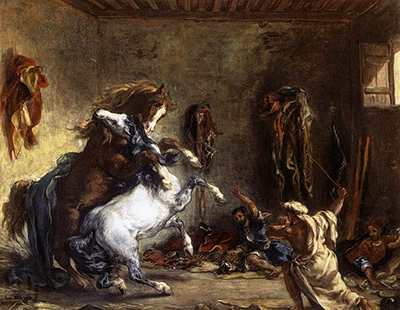Arab Horses Fighting in a Stable is one of Delacroix' last paintings, dating from 1860, but it reflects an attraction to scenes of wildness and savagery that had been evident right from the beginning of his career.
These horses are untamable, powerful beasts, not elegantly glossy animals, and their energy calls forth a spontaneous and forceful approach from the painter.
English painter George Stubbs, as well as the French painter Gericault who was a major influence on Delacroix, had painted similar scenes of horses fighting. But in this case, Delacroix based his painting on a real life event, a fight between Arab horses he'd seen on his trip to Morocco.
Delacroix uses strong contrasts of colour as well as of light and shade to intensify the emotional content of the scene.
The light comes from a tiny square window at the top right corner of the painting, falling on the flank of the white horse and making it dazzlingly bright.
The dark horse, behind, is raising its head to bite, its mane flying, and the white blaze on its dark head seems to make a diagonal reflection of the white horse's head.
A further slug of energy is added to the painting by the figure rushing in with his whip raised. Less fortunate or less courageous grooms sprawl on the floor, in the shadows.
The people in the scene, though, are not Delacroix' real interest. With the single exception of the white draped horse-tamer, they are shown as passive or afraid, their attitudes contrasted with the wild energy of the Arab horses.
Delacroix' trip to Morocco had changed his career as an artist, introducing him to a fascinating new world and to the bright and varied colours of the Moroccan cities and landscapes.
In this painting he seems to sum up the energy and wildness that can still be seen in Moroccan horse 'fantasias' to this day.




